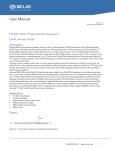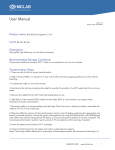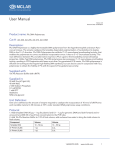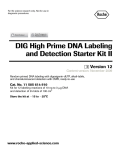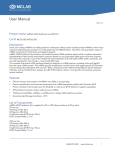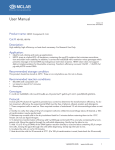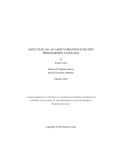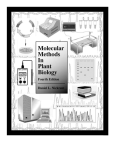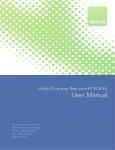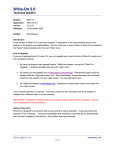Download User Manual
Transcript
Molecular Cloning Laboratories User Manual Version 2.0 Product name: T7 High Yield In vitro Transcription Kit Cat #: T7HT-100, T7HT-200 Description: Phage RNA polymerases are widely used for in vitro synthesis of RNA transcripts from DNA templates which have a double-stranded promoter (at least 19 bases) upstream of the sequence to be transcribed. T7 phage RNA polymerase has a high specificity for its respective promoter. Once T7 RNA polymerase binds to its double-stranded DNA promoter, it separates the two DNA strands, and uses the 3’ to 5’ strand as a template for 5’ to 3’ transcription at the end of the DNA template (run-off transcription) (Figure 1). The initiation of transcription is the rate-limiting step in in vitro transcript reactions. Elongation of the transcript is very fast and efficient. Cloning vectors usually contain two or more separate phage promoters flanking a multiple cloning site. So either strand of the template can be transcribed from the promoter on the opposite strand. The T7 High Yield In vitro Transcription Kit can also be used to transcribe from DNA templates produced via PCR or synthetic DNA oligonucleotides. Because RNA-RNA and RNA-DNA hybrids are more stable than DNA-DNA duplexes in solid base hybridizations, and single-stranded RNA probes are not depleted by rehybridization to a complementary probe strand, the T7 High Yield In vitro Transcription Kit can be used to incorporate isotopically labeled as well as nonisotopically modified nucleotides into RNA transcripts as probes for hybridization reactions, such as Northern and Southern blotting, slot or dot blotting, in situ hybridizations, and nuclease protection assays. If the RNA produced will be used as a probe to detect mRNA, it is important that mRNA-complementary (antisense) transcripts are synthesized. With custom supplied cap analog, fully functional capped mRNAs can be made through T7 High Yield In vitro Transcription reactions. Applications: • • • • • • In vitro transcription In vitro translation Hybridization probes Generation RNase protection assays RNA binding protein assays RNAi study Figure: Figure 1. T7 promoter sequence needed for transcription 1-(650) 872-0245 www.mclab.com 1 List of Components The kit contains sufficient materials for 20 or 100 reactions at 20 μL total reaction volume. 20 rxns Component 20 μL T7 Enzyme Mix 20 μL ATP Solution (50 mM) 20 μL CTP Solution (50 mM) 20 μL GTP Solution (50 mM) 20 μL UTP Solution (50 mM) 20 μL 100 mM DTT 250 μL 10X Transcription Buffer 10 μL Control DNA Template (0.5 μg/μL) 1.5 mL Nuclease-free Water 100 rxns Component 100 μL T7 Enzyme Mix 100 μL ATP Solution (50 mM) 100 μL CTP Solution (50 mM) 100 μL GTP Solution (50 mM) 100 μL UTP Solution (50 mM) 100 μL 100 mM DTT 250 μL 10X Transcription Buffer 10 μL Control DNA Template (0.5 μg/μL) 1.5 mL Nuclease-free Water The kit should be stored at –20°C in a non frost-free freezer. Nuclease-free Water can be stored at room temperature, 4°C, or –20°C. Additional Materials Required (Materials Not Provided with the Kit) • Spin Columns • Thermocycler or incubator • (optional) Labeled nucleotide Generally 32P-UTP or CTP, at about 800 Ci/mmol and 10 mCi/mL or greater in aqueous solution, is recommended for synthesis of radioactive probes. 33 P, 35S, 3H, fluoresceinated, biotinylated, and digoxigenin nucleotides can also be used. • (optional) Ammonium Acetate solution • (optional) Buffer-saturated phenol:chloroform:IAA • (optional) DNase I (RNase free) • (optional) Ethanol: ACS reagent grade • (optional) Isopropanol • (optional) LiCl solution • (optional) Gels, running buffers, loading dyes and gel box Standard Procedure Take all precautions to avoid RNase contamination during the whole process. Reactions are typically 20 μL but can be scaled up as needed. 2 A. Preparation of Template DNA Generally, any DNA with an RNA polymerase promoter site can be used as templates for in vitro transcription. DNA should be relatively free of contaminating proteins and RNA. Mostly used DNA templates are linearized plasmid DNA or PCR products that contains a promoter site for in vitro transcription. B. Transcription Reaction Setup 1. Thaw the frozen reagents and place on ice. After thaw, vortex the 10X Transcription Buffer and keep it at room temperature. All reagents should be spun briefly before opening to prevent loss and/or contamination. 2. Assemble the reaction Assemble the reaction at room temperature as the following chart when the RNA produced will be ≥0.5 kb in length. For transcripts shorter than this, we recommend add 1-fold more water to the reaction and increase incubation time longer than standard time as well. Add the 10X Transcription Buffer after the water and template DNA are already in the tube. Component Amount Nuclease-free Water to 20 µL ATP solution 1 µL CTP solution 1 µL GTP solution 1 µL UTP solution 1 µL DTT 1 µL (optional) [α-32P]UTP* 1 µL Template DNA** x 10X Reaction Buffer 2 µL Enzyme Mix 1 µL *: Can be included in the reaction as a tracer. **: 0.1-0.2 μg PCR product or up to 2 μg linearized plasmid DNA. Denature first for un-fresh linearized plasmid DNA. 3. Mix thoroughly and then spin down briefly. 4. Incubate at 37°C, 2 – 4 hr The optimal incubation time for a given template will vary depending on the size and transcriptional efficiency of your template. For short transcripts (< 0.5 kb), a longer incubation time (up to ~16 hours) may be necessary for maximum yield. If the reaction is trace-labeled, remove an aliquot of trace-radiolabeled reactions to assess yield after the incubation. C. (optional) DNase treatment DNase treatment removes the template DNA. For many applications it may not be necessary. D. Recovery of the RNA Different purification methods after the transcription reaction should be chosen according to your application and resources. Some commercial kits such as column purification are available specifically for purifying RNA from in vitro transcription reactions. Applications that require primarily full length probe (ribonuclease protection assays, and mapping studies), gel purification should be the choice. Other common methods are listed as below. 1-(650) 872-0245 www.mclab.com 3 1. Lithium chloride precipitation Lithium Chloride (LiCl) precipitation is a convenient and effective way to remove unincorporated nucleotides and most proteins for RNAs longer than 300 nucleotides and over 0.1 µg/µL. a. Precipitate the RNA by adding 30 µL Nuclease-free Water and 30 µL LiCl solution (7.5 M lithium chloride, 50 mM EDTA). b. Mix thoroughly. Chill for ≥30 min at –20°C. c. Centrifuge at 4°C for 15 min at maximum speed. Carefully remove the supernatant. d. Wash the pellet once with ~1 mL 70% ethanol, and re-centrifuge, carefully remove ethanol. e. Resuspend the RNA in a solution appropriate for your application. 2. Phenol:chloroform extraction and isopropanol precipitation This is the most rigorous method for purifying transcripts. a. Add 115 μL nuclease-free water and 15 μL ammonium acetate solution (5 M ammonium acetate, 100 mM EDTA), mix thoroughly. b. Add equal volume of phenol/chloroform, and then with an equal volume of chloroform. Mix well. Recover aqueous phase and transfer to a new tube. c. Adding 1 volume of isopropanol and mixing well. d. Chill the mixture for at least 15 min at –20°C. Centrifuge at 4°C for 15 min at maximum speed. Carefully remove the supernatant and resuspend the RNA in a solution appropriate to your application. E. Determine the RNA concentration and store frozen at –20°C or –80°C. Ethidium bromide fluorescence, UV light absorbance, trace radiolabeling could be used for quantitating RNA yield. RiboGreen and Bianalyzer kits are both convenient and sensitive methods as well. Troubleshooting A. Control Reaction The control template DNA is a linearized plasmid containing synthesized sequence under the transcriptional control of T7 promoter. The size of the runoff transcript is 0.3 kb. If the control reaction is not working, there may be technical problems during the reaction set up. B. Low Yield of Short Transcript High yields of short transcripts (< 0.3 kb) could be achieved by extending incubation time and increasing the amount of template. To determine the optimum incubation time for maximum yield with a given template, a time-course experiment can be done. C. Low Yield of Full-length RNA If the transcription reaction with your template generates full-length RNA, but the yield is significantly lower than expected, it is possible that contaminants in the DNA template are inhibiting the RNA polymerase, or the DNA concentration may be incorrect. D. Significant fragments of RNA Transcript If the RNA appears degraded (e.g., smeared on gel), RNase contamination might be the issue, either from DNA template or the reaction set up. E. RNA Transcript of Smaller Size than Expected Smaller than the expected sized bands are most likely due to premature termination by the RNA polymerase due to some sequences within template resemblance to T7 RNA Polymerase termination signals. Incubating the transcription reaction at lower temperatures might be helpful. For GC rich templates, or templates with secondary structures, incubation at 42°C or use of single-stranded DNA binding protein (SSB) may improve the yield of full-length transcript. 4 F. RNA Transcript of Larger Size than Expected If the RNA transcript appears larger than expected, template plasmid DNA may be incompletely digested. Larger size band on gel may also be observed when the RNA transcript is not completely denatured due to the presence of strong secondary structures. Reference: Schendorn ET and Mierindorf RC (1985). Nucleic Acids Res, 13,6223-6236 1-(650) 872-0245 www.mclab.com 5





